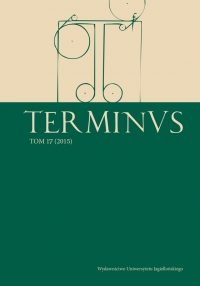Idea wymowy opartej na argucji i pełnej fi nezji, w przekładzie i opracowaniu Iwony Słomak i Kacpra Kardasa
The Idea of witty and ingenious eloquence
Author(s): Emanuele TesauroSubject(s): Other Language Literature, 17th Century, Theory of Literature
Published by: Wydawnictwo Uniwersytetu Jagiellońskiego
Keywords: Emanuele Tesauro; Il cannocchiale aristotelico; argutia; witty and ingenious eloquence; rhetoric;
Summary/Abstract: The intention of the authors of the translation and of commentary on the presented chapter of Emanuele Tesauro’s (1591–1677) Idea argutae et ingeniosae dictionis... (The Idea of witty and ingenious eloquence; the Italian title: Il cannocchiale aristotelico o sia idea dell’arguta et ingeniosa elocutione...) is to introduce Polish readers to the content of the work, which is one of the broadest and most interesting and influential 17th century approaches to the issue of argutia (smartness, conciseness, wittiness), and, at the same time, is difficult to read because of the subtlety and erudition of his discourse. The book was written as a result of a long search and deep reflection of its author, a man of wide interests and a poet and prose writer of great achievement. In addition to Il cannocchiale aristotelico..., Tesauro published collections of eulogies and occasional poetry in Latin, widely known in Europe, and also, in his native language, a number of historical monographs and dramatic works, a philosophical and moral treatise, and a manual on the art of writing letters. The treatise on argutia was written in several phases. Although the author had worked on it since his youth, he only published it as an mature man (first edition: Turin 1654). Subsequently, he expanded it and improved it until 1670. Th e work was republished in Italy many times, both in Tesauro’s lifetime and aft er his death. However, as indicated by the publisher of the Latin translation of the work, Il cannocchiale aristotelico was not widely known north of Italy. It was not until the Latin edition was published in 1698 (Frankfurt-Leipzig) and later in 1714 that the situation began to change. Hence, the current translation into Polish is based principally on the Latin text, which is, in fact, consulted with the Italian edition.
Journal: TERMINUS
- Issue Year: 17/2015
- Issue No: 3 (36)
- Page Range: 379-416
- Page Count: 38
- Language: Polish

